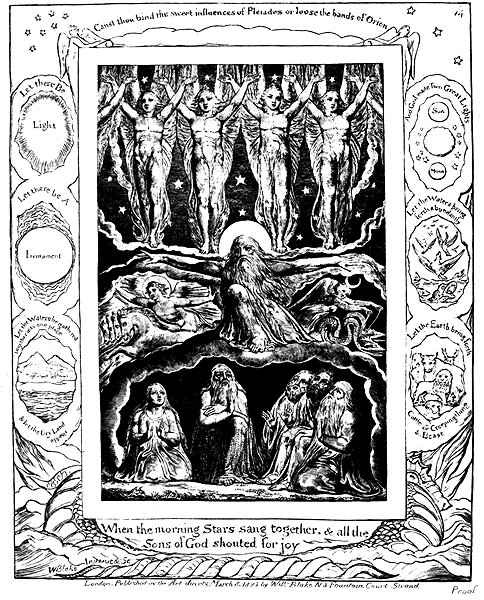 This image from Blake's last work is certainly a Sublime Allegory.
This image from Blake's last work is certainly a Sublime Allegory.Each of these two words has a definite meaning:
SUBLIME is a chemical term: ice, a solid, may melt into water or it may sublime into a gaseous form, perhaps fog or a cloud.
Blake used sublime in a similar way; in July, 1803, still at Felpham but expecting shortly to return to London, Blake wrote to his friend (and spiritual director) Mr. Butts, including these lines:
"I hope that all our three years trouble Ends in Good Luck at last & shall be forgot by my affections & only rememberd by my Understanding to be a Memento in time to come & to speak to future generations by a Sublime Allegory which is now perfectly completed into a Grand Poem" Jerusalem of course and a little way on "I may praise it since I dare not pretend to be any other than the Secretary the Authors are in Eternity I consider it as the Grandest Poem that This World Contains [pretty healthy ego, eh?].
Allegory addressd to the Intellectual powers while it is altogether hidden from the Corporeal Understanding is My Definition of the Most Sublime Poetry. it is also somewhat in the same manner defind by Plato"; these are extravagant words from a poet who has just ebulliently completely his masterpiece and is about to escape from the toils of his 'corporeal friend' William Hayley.
ALLEGORY "A figurative mode of representation conveying meaning other than the literal. Allegory communicates its message by means of symbolic figures, actions or symbolic representation", according to this article in Wikipedia. You might say that most or all of Blake's poetry is allegorical.
In the letter to Butts he particularly referred to 'Jerusalem' as a Sublime Allegory; it dealt with the divine, the Eternal and especially this Reality underneath and pervading the material Events of our lives, especially his life. Most of it is autobiographical and applied equally to all human beings.
Blake had been at this sort of thing for a long time, since his earliest poetry. In another letter he told us his 'heavenly' visions had left him for 20 years before his renewal and enlightenment in 1803. Up to that time he allegorized, but they weren't sublime allegories. It's easy for example to see the difference between Night One of the Four Zoas and Night 9 (where he expressed his visions of the parousia.
The major prophetic works, 'Milton' and 'Jerusalem' show a very different man from the one who came up with The Marriage of Heaven and Hell, and the subsequent 'Bible of Hell':
IMO the most extremely sublime allegory came from Blake's last work:
The Illustrations to the Book of Job, a sample of which appears at the beginning of this post.
No comments:
Post a Comment